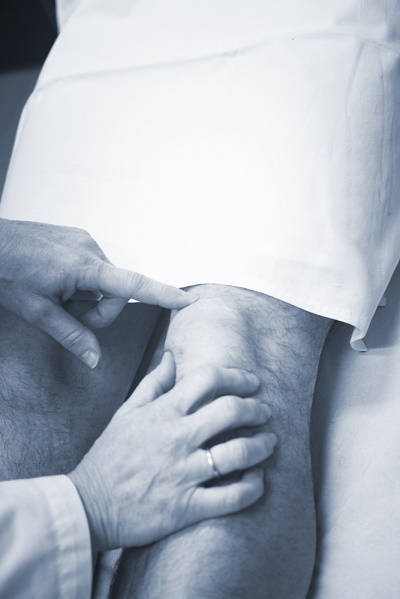For the most part, knee replacement surgery or total knee arthroplasty is a very common operative procedure. In fact, in the last 20 years, knee replacement surgery has increased in volume by about 160%. And it’s projected that the number of total knee revisions is projected to increase by 600% in the next 15 years. A knee replacement revision occurs after your initial total knee replacement fails or wears out. If you’re preparing for knee replacement surgery, follow along for the latest research and insights.
Preoperative History – Preparing for Knee Replacement
Before knee replacement surgery, your orthopedic surgeon will assess the presence of your comorbid condition. This includes smoking status, alcohol consumption, medication, and mental status. These are very important to help guide preoperative evaluation and medical optimization.
Dr. Michael Tanzer and Dr. Makhdom published a review article on preparing for knee replacement in the Journal of American Academy of Orthopedic Surgeons in April 2016. The authors identified areas that must be looked at prior to joint replacement surgery. This is done to make sure that the patient awaiting surgery does not have any active infections or other health conditions that would negatively affect surgical outcomes.
 When preparing for knee replacement surgery, you should be assessed for your overall venous thromboembolic risk. This is the risk for developing a blood clot. Your doctor should ask you if you’ve ever had a blood clot or pulmonary embolism. And if you have, your surgeon may require that you see a hematologist to evaluate why. Your doctor will want to prevent another blood clot from occurring.
When preparing for knee replacement surgery, you should be assessed for your overall venous thromboembolic risk. This is the risk for developing a blood clot. Your doctor should ask you if you’ve ever had a blood clot or pulmonary embolism. And if you have, your surgeon may require that you see a hematologist to evaluate why. Your doctor will want to prevent another blood clot from occurring.
Also, your social history will be evaluated. This is important regarding postoperative rehabilitation and discharge planning from a hospital. It should be of note that more total knee replacements are now being done as an outpatient procedure. When preparing for knee replacement, in-home rehab and in-home nursing care will need to be set up before the surgery.
The physician will also identify independent risk factors for complications that occur around the perioperative period. This includes dementia, history of diabetes, morbid obesity with a BMI of greater than 40, renal and cerebral vascular disease. Studies show that postoperative complications are much higher in patients that have these diagnoses.
Your doctor may ask you if you had a neuromuscular condition such as Parkinson’s. This is important since it can cause postoperative instability of the knee replacement.
If your surgeon notes that you have a history of one or more of these conditions, the risk of surgery may outweigh the benefit of a knee replacement.
Physical Examination When Preparing for Knee Surgery
During your physical examination, your knee surgeon will look at your gait pattern. That may indicate whether you need a special type of knee replacement, called a constraint knee design. The assessment of prior surgical scars will be identified because that may change the way the surgeon makes an incision for total knee replacement. A 5 to 6 cm of skin bridging between the new incision and the old incision is desirable to avoid postoperative pain complications. Your doctor will also examine your skin to see if there is any sign of infection or cellulitis or adherence to the underlying bone.
Additionally, your orthopedic surgeon will evaluate your range of motion. We know that if your knee is stiff before surgery, that is the biggest risk factor for having a stiff knee postoperatively. Identification of preoperative knee stiffness can help the surgeon plan intraoperative strategy for correction.
Stability of the knee will also be evaluated to determine whether there is any ligament damage. If there is any ligamentous laxity, a special type of joint replacement may be needed. A neurovascular examination will also be conducted. The surgeon will note any signs of poor circulation. This includes: skin discoloration, absent hair, atrophic nails involving the toes or asymmetric or absent pulses.
If there is any suspicion of peripheral vascular disease or poor blood flow to the leg, an ankle-brachial index should be obtained and a preoperative vascular surgeon consultation may be warranted. We know that patients with preexisting peripheral vascular disease are at high risk for arterial injury and compromise blood flow during a total knee replacement. The surgeon may not use a tourniquet during the procedure or inflating at the time the cement is being placed.
Assessment of the hip and ankle on that side of the leg should also be evaluated. Hip arthritis on the same side of the surgery to be performed may present an isolated knee pain and must be ruled out.
Radiographic Templating When Preparing for Knee Surgery
Prior to your surgery, your surgeon will obtain plain x-rays of your knee to evaluate the degree of the arthritis and the angulatory deformity of the lower extremities.
Preoperative laboratory testing is done to  make sure your hemoglobin level is in an appropriate range. If it’s not, you may be given some medication to improve the hemoglobin level. A low hemoglobin level is an independent predictor for a perioperative blood transfusion. The risk of transfusion is increased 3.7 folds for each 1 g/dL decrease in the hemoglobin level below the threshold of 13 g/dL preoperatively. Ideally, we would like all patients to have a hemoglobin greater than 13 preoperatively.
make sure your hemoglobin level is in an appropriate range. If it’s not, you may be given some medication to improve the hemoglobin level. A low hemoglobin level is an independent predictor for a perioperative blood transfusion. The risk of transfusion is increased 3.7 folds for each 1 g/dL decrease in the hemoglobin level below the threshold of 13 g/dL preoperatively. Ideally, we would like all patients to have a hemoglobin greater than 13 preoperatively.
If you are diabetic you’ll need a hemoglobin A1c. We would like to have a hemoglobin A1c less than 7 and at most less than 8.
In summary, preoperative planning is critical for patients preparing for knee replacement surgery. A thorough preoperative history, physical examination, and radiographic templating results in a precise plan that helps the surgeon anticipate potential complications and successfully reconstruct the knee.

Recent Comments